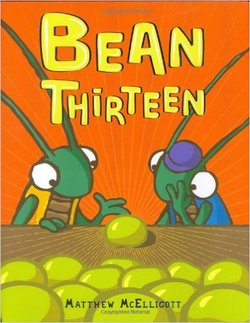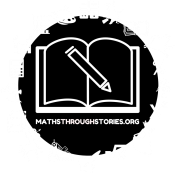BEAN THIRTEEN
Author: Matthew McElligott
Illustrator: Matthew McElligott
|
Number of pages: 29
Publisher: Penguin's Putnam Publishing Group (USA) First published in: 2007 Format: Picturebook Is the mathematical focus explicit in the story? Yes Is this story part of a mathematics story series? No Preview and/or purchase this book on the Amazon websites: UK, USA, AUS, CAN Synopsis by the author/publisher
Ralph warns Flora not to pick that thirteenth bean. Everyone knows it's unlucky! Now that they're stuck with it, how can they make it disappear? If they each eat half the beans, there's still one left over. And if they invite a friend over, they each eat four beans, but there's still one left over! And four friends could each eat three beans, but there's still one left over! HOW WILL THEY ESCAPE THE CURSE OF BEAN THIRTEEN?! A funny story about beans, that may secretly be about ... math! Sometimes you can divide, but you just can't conquer (the bean thirteen, that is). |
“But something still wasn't right. "Why does Rocco get three beans?" complained Ralph. "That's more than anyone else." "Well, we could give him two," said Flora, "but ..." [...] "Tell me," said Ralph. "But what?" "It's just that we'll still have an extra bean," said Flora. "I'm really not sure why."”
Official review by MathsThroughStories.org
At the time of writing this review, Matthew McElligott’s ‘Bean Thirteen’ (2007) is, as far as we are concerned, the only mathematical story in the market with an explicit focus on properties of prime numbers, specifically thirteen. Not only does this story provide a great introduction to the concept of prime numbers, it can, of course, also be used to teach division and the concept of remainders. The story follows two crickets, Ralph and Flora, who have collected twelve beans to bring home for dinner. When Flora decides to pick one more bean (i.e. Bean Thirteen), Ralph is convinced it will bring bad luck. No matter how many friends they invite to share the beans equally, Bean Thirteen is always there on its own. What would Ralph and Flora do to solve this problem!? The story lends itself perfectly to encouraging young readers to investigate which other numbers have the same property as thirteen. The storyline is engaging and humorous, with believable and cute characters. ‘Bean Thirteen’ is charmingly illustrated by Matthew. The mathematical visualisation is clear, helpful and accurate. Gender representation in the cast is fair. All in all, we highly recommend ‘Bean Thirteen’. Recommended for children aged 6+ years old.
Recommended age range:
6+ years old
Relevant topics:
Division; Prime numbers
Possible teaching activities:
At MathsThroughStories.org, we believe that stories can be meaningfully incorporated in mathematics teaching in different ways. Thus, we are inviting you to share your experience of how you have used this story in your mathematics lesson with other members of the community. By sharing your experience with us, you will be added to our team of On-line Contributors here, where you can also find our submission guideline.
At the time of writing this review, Matthew McElligott’s ‘Bean Thirteen’ (2007) is, as far as we are concerned, the only mathematical story in the market with an explicit focus on properties of prime numbers, specifically thirteen. Not only does this story provide a great introduction to the concept of prime numbers, it can, of course, also be used to teach division and the concept of remainders. The story follows two crickets, Ralph and Flora, who have collected twelve beans to bring home for dinner. When Flora decides to pick one more bean (i.e. Bean Thirteen), Ralph is convinced it will bring bad luck. No matter how many friends they invite to share the beans equally, Bean Thirteen is always there on its own. What would Ralph and Flora do to solve this problem!? The story lends itself perfectly to encouraging young readers to investigate which other numbers have the same property as thirteen. The storyline is engaging and humorous, with believable and cute characters. ‘Bean Thirteen’ is charmingly illustrated by Matthew. The mathematical visualisation is clear, helpful and accurate. Gender representation in the cast is fair. All in all, we highly recommend ‘Bean Thirteen’. Recommended for children aged 6+ years old.
Recommended age range:
6+ years old
Relevant topics:
Division; Prime numbers
Possible teaching activities:
At MathsThroughStories.org, we believe that stories can be meaningfully incorporated in mathematics teaching in different ways. Thus, we are inviting you to share your experience of how you have used this story in your mathematics lesson with other members of the community. By sharing your experience with us, you will be added to our team of On-line Contributors here, where you can also find our submission guideline.

